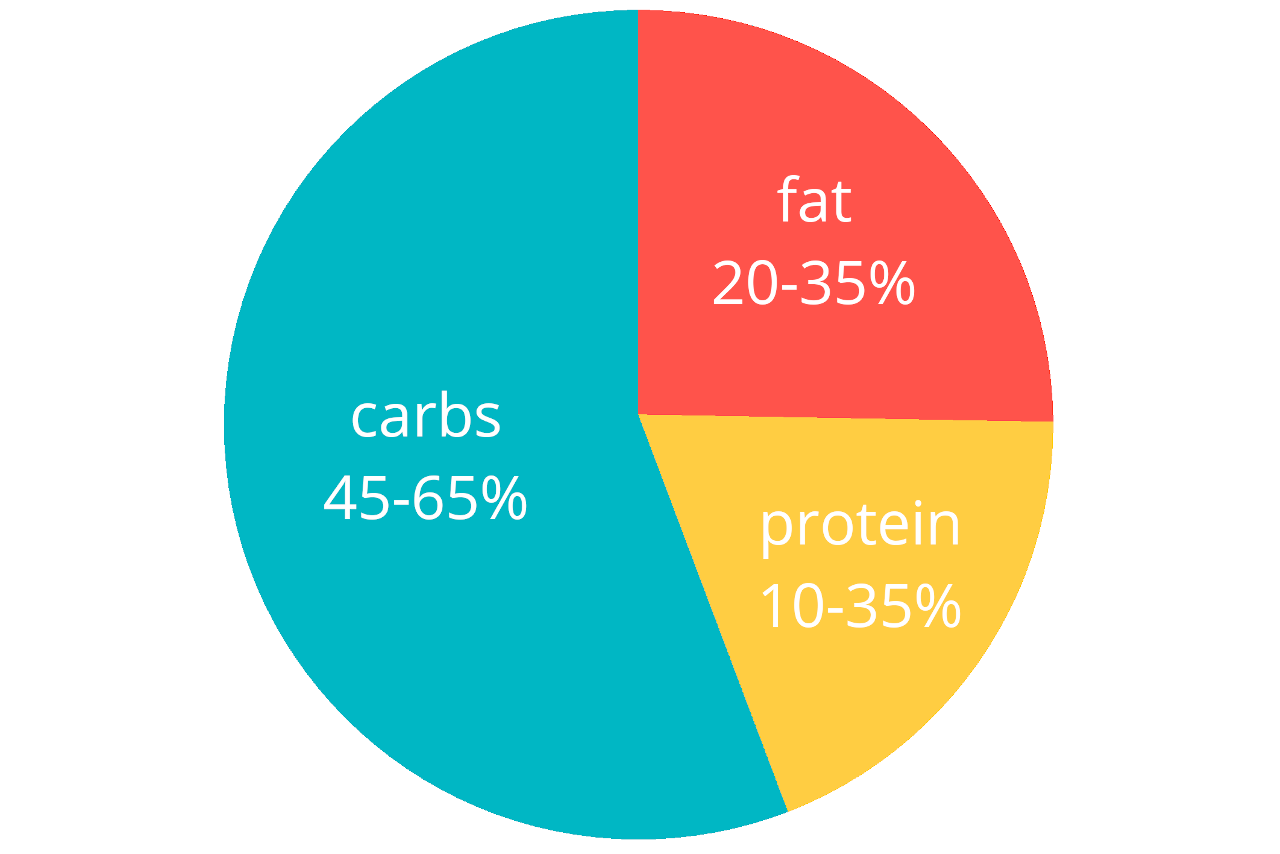Fat Calculator – Calculate Ideal Fat Intake
Enter your age, height, weight, activity level, and nutrition goal to calculate how much fat you should eat per day.
On this page:
How Much Fat Should You Eat Per Day?
The word “fat” tends to have a negative connotation. But the truth is, just like carbs and protein, fat is an essential macronutrient that plays a vital role in overall health. Fat is a required nutrient in every normal diet.
Fat not only provides energy, but is also a component of cell membranes and stores the fat-soluble vitamins A, D, E, and K. You should consume fat as part of an overall healthy eating program.
To figure out how much fat you should eat each day, first calculate your total daily calorie needs. From this, you can determine the right proportion of calories that should come from fat based on your individual needs.
For the average adult, the National Academy of Sciences and the Dietary Guidelines for Americans 2020-2025 recommends that 20-35% of your total daily calorie intake should come from fats.[2]

Even if you are an athlete and are extremely active, fat intake is still essential. Fat intake should still range from 20% to 35% of total energy intake.
Consuming ≤20% of energy from fat does not benefit performance, according to position statements from The American Dietetic Association, Dietitians of Canada, and the American College of Sports Medicine: Nutrition and Athletic Performance.[3]
How to Calculate Fat Intake
Your daily fat intake will be a percentage of your total daily calorie needs. This means the first step in determining daily fat intake is to calculate your total daily energy expenditure (TDEE). This is based on your basal metabolic rate (BMR) multiplied by your activity factor.
Your total daily energy expenditure is an estimate of the total number of calories you should eat each day. These calories will need to come from a combination of protein, fat, and carbohydrates.
Calculating how much of each macronutrient you should consume is commonly known as “counting macros.” The proportion of each macronutrient that you should include in your diet will depend on your current weight, activity level, and fitness goals.
Daily Fat Intake
Fat intake should be sufficient to provide the essential fatty acids and fat-soluble vitamins, as well as contribute energy for weight maintenance. In general, this will range from 20-35%.
This is a wide range, and you can determine your specific percentage based on your goals and activity level.
This table is a helpful guideline for calculating proportions of macronutrients based on your fitness goals.
| Goal | Protein | Carbohydrate | Fat |
|---|---|---|---|
| General Fitness | 10-15% | 45-55% | 25-35% |
| Medium to High Intensity Fitness (1-2 hours/day, 4-6 days/week) |
20-30% | 55-65% | 30% |
| Weight Loss | 25-30% | 45-50% | 20-25% |
Grams of Fat Per Day
By taking your daily calorie needs and multiplying this by 20 to 35%, you will then have the number of calories you should consume from fat each day.
You can then convert calories from fat into grams of fat. One gram of fat provides nine calories. Therefore, if you divide calories from fat by nine, this will give you your recommended fat intake in grams for the day.
| Macronutrient | Calories per Gram |
|---|---|
| Fat | 9 kcal |
| Carbohydrate | 4 kcal |
| Protein | 4 kcal |
Recommended Fat Intake
Your recommended fat intake will also depend on whether you are aiming to lose weight, maintain your current weight, or gain muscle. Counting macros is an effective method to aid in weight loss, and this includes calculating your fat intake based on a calorie deficit.
Determining the amount of fat you should eat each day will be based on your calorie requirements for safe weight loss. One method for doing this is to calculate how many calories you should eat to maintain your current weight, and then subtract 500 calories from this.
This will give you a calorie deficit that can result in safe weight loss of one pound per week if consistently maintained, and hopefully, a reduction in body fat. However, this will also depend on other factors, such as gender, age, genetics, hormones, and the type of exercise in which you engage.
Fat Recommendation for Ketogenic Diet
The ketogenic diet is a popular diet trend that was originally used as a way to manage seizures and is now being used for a variety of health reasons, including weight loss.[5]
The original ketogenic diet limits carbohydrates to less than 50g per day.[5] This is a very restrictive diet and can be unpalatable for many people. To increase compliance with the diet, variations of the ketogenic diet have been developed. The term “ketogenic diet” or “keto diet” is now used to loosely describe a diet with the main characteristic being that the diet is very low in carbohydrates, moderate in protein, and high in fat.[5]
The idea behind the keto diet is that the ultimate fuel supply for your body becomes fat when you eat this way. This lowers your insulin levels, which decreases fat storage and intensifies fat burning.[5]
You should consult your physician or dietitian before engaging in high-fat diets to ensure this is a safe dietary approach for you to take. There are some people who should not choose this diet.
Healthy Fat Consumption
The type of fat that you consume is also important. Not all fat calories are created equal, and the quality of the food that you consume is just as important as the quantity.
There are foods that are considered “healthy fats”, while other unhealthy fats can contribute to obesity, heart disease, high cholesterol, and other chronic diseases.
When it comes to fats in the diet, try to stay away from large amounts of saturated fats and stick to foods containing the omega-3 fatty acids eicosapentaenoic acid (EPA), docosahexaenoic acid (DLA), and α-linolenic acid (ALA). Omega-3 fatty acids have been shown to reduce the incidence of cardiovascular disease.[6]
Recommendations from the American Heart Association Dietary Guidelines suggest including at least two servings of fish per week (particularly fatty fish).[6]
In addition, the data support the inclusion of certain vegetable oils (e.g., soybean, canola, walnut, flaxseed) and foods such as walnuts, flaxseeds high in α-linolenic acid in a healthy diet for the general population.[6]

Saturated fats should be limited to less than 10% of total calorie intake. Foods high in saturated fat include butter, certain oils, creams, fatty beef, lamb, and dairy products made with whole milk.
Many fast foods and processed foods are made with saturated fats and should be limited. For example, studies have found that lowering the intake of dietary saturated fat and replacing it with polyunsaturated vegetable oil can reduce cardiovascular disease by about 30%.[7]

By utilizing the TDEE calculator along with calculating your macronutrients, including fat intake, you can determine the amount of fat that you should eat daily.
References
- Institute of Medicine of the National Academies, Dietary Reference Intakes - The Essential Guide to Nutrient Requirements, https://nap.nationalacademies.org/read/11537/chapter/1
- U.S. Department of Agriculture, Dietary Guidelines for Americans 2020-2025, https://www.dietaryguidelines.gov/sites/default/files/2021-03/Dietary_Guidelines_for_Americans-2020-2025.pdf
- Rodriguez, N. R., DiMarco, N. M., & Langley, S., Position of the American Dietetic Association, Dietitians of Canada, and the American College of Sports Medicine: Nutrition and athletic performance, Journal of the American Dietetic Association, 2009, 109(3), 509-527. https://www.jandonline.org/article/S0002-8223(09)00006-6/fulltext
- Bachus, T., How to Determine the Best Macronutrient Ratio for Your Goals, American Council on Exercise, 2016, April 15, https://www.acefitness.org/resources/pros/expert-articles/5904/how-to-determine-the-best-macronutrient-ratio-for-your-goals/
- Crosby, L., Davis, B., Joshi, S., Jardine, M., Paul, J., Neola, M., & Barnard, N. D., Ketogenic Diets and Chronic Disease: Weighing the Benefits Against the Risks, Frontiers in Nutrition, 2021, 8, https://doi.org/10.3389/fnut.2021.702802
- Kris-Etherton, P. M., Harris, W. S., & Appel, L. J., Fish consumption, fish oil, omega-3 fatty acids, and cardiovascular disease, Circulation, 2002, 106(21), 2747-2757. https://www.ahajournals.org/doi/full/10.1161/01.CIR.0000038493.65177.94
- Sacks, F. M., Lichtenstein, A. H., Wu, J. H., Appel, L. J., Creager, M. A., Kris-Etherton, P. M., Miller, M., Rimm, E. B., Rudel, L. L., Robinson, J. G., Stone, N. J., & Van Horn, L. V., Dietary fats and cardiovascular disease: a presidential advisory from the American Heart Association, Circulation, 2017, 136(3), e1-e23. https://www.ahajournals.org/doi/full/10.1161/CIR.0000000000000510



